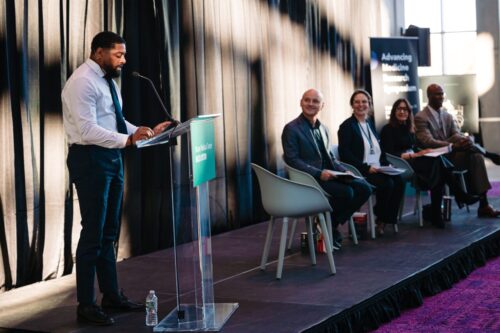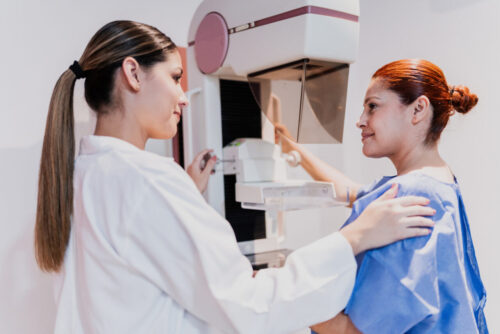Clean Socks Are Simple Way to Reach Patients Experiencing Homelessness
October 18, 2022
By Isabella Bellini, By Katie Dillon

Courtesy of Bombas
Upstream healthcare solutions are critical, but this essential need offers preventative treatment and relationship-building crucial to patient care.
It’s no secret that homelessness is a pervasive, persistent problem in all areas of the United States. Most cities and towns have visible evidence of their unhoused neighbors — encampments scattered throughout areas of the city, people sleeping on park benches or in subway stations. This humanitarian crisis is often right under our noses.
The current state of homelessness
The ongoing COVID-19 pandemic, the rising cost of living, and the current opioid epidemic seem to have created a recipe for a sharp rise in people experiencing homelessness or having unstable housing. That very well could be the case, but according to Bloomberg, national data on homelessness remains inconclusive because many cities and towns across the country were forced to cancel or condense their annual data counts of homeless populations in their areas due to the pandemic in 2021. This, along with the decongestion of shelters across the country, has resulted in garbled data as to the actual state of homelessness.
Boston — in contrast to Bloomberg’s findings — has conducted two socially distant point-in-time census counts of its unhoused population since the onset of the pandemic. According to the data released by the Mayor’s Office of Housing, numbers for unsheltered and housing insecure individuals decreased from 2021 to 2022. David Munson, MD, a street doctor and the medical director of Boston Health Care for the Homeless Program’s (BHCHP) Street Team points out that this conclusion is more complex than meets the eye.
Boston’s Point in Time census of unhoused people is done in January. In Boston, this is typically a time when there are fewer people on the streets due to extreme changes in the weather.
“A lot of people will use whatever social capital they have during the winter months and stay with friends or family,” Munson explains.
Though many of Boston’s shelters do not require sobriety as a condition of admittance, most prohibit the use of substances on their premises. This presents challenges for those individuals who need more frequent use to alleviate the symptoms of withdrawal, meaning many don’t seek shelter at all. For its part, the City of Boston, along with partners including Boston Medical Center (BMC), worked to secure low-threshold housing at places like the Roundhouse Hotel, which also likely is a factor in the downward trend of street homelessness in Boston captured last winter.
Using socks as a way to build community with patients experiencing homelessness
Whether you are a sole individual or part of a family, the realities of homelessness or housing insecurity are detrimental to a person’s health and quality of life. BMC and Boston Health Care for the Homeless are among many other organizations in Boston that are treating individuals impacted by homelessness or housing insecurity.
Individuals experiencing homelessness are plagued by a variety of health issues, including HIV, lung issues (like bronchitis), malnutrition, substance use disorder, mental health issues, and wounds and abscesses which, left untreated, are prone to infection. Foot health, says Munson, is “a wonderful window into how somebody’s doing.” Trench foot, fungal infections, skin wounds, or infections related to untreated or mismanaged diabetes or peripheral vascular disease are some of the most common foot ailments that plague individuals experiencing long-term street homelessness.
“Sometimes preventative treatment for a recurrence of these infections is as simple as a pair of clean socks,” says Munson. People experiencing homelessness are often preoccupied with day-to-day survival, mired by the precariousness of not knowing where your next meal will come from, or where you’ll sleep that night. Given that, clean clothes often fall low on the hierarchy of needs.
One company has truly been a driving force in addressing the clothing needs of the unhoused population in Boston and around the United States. People experiencing homelessness are typically in need of basics: socks, underwear, and shirts. After Bombas founders Randy Goldberg and David Heath learned that socks are the number one most requested item in homeless shelters, they created a company that would donate a pair of socks to people experiencing homelessness for every pair purchased. Now, in 2022, Bombas has expanded to sell and donate more than socks. They now offer underwear and t-shirts, the second and third most requested items at homeless shelters.
“Bombas’ ability to give back is fueled by our incredible customers. Since we are set up to donate an item for every item sold, we couldn’t do what we do without their support,” says Kelly Cobb, Bombas vice president of Giving. “We also couldn’t do what we do without our Giving Partner network, which consists of over 3,500 organizations across the U.S. and which ensures that our donation products get into the hands (and onto the feet) of those who need it most.”
Their goods are designed to be durable as well as comfortable and versatile, and they show less visible wear, according to Bombas’ website. While all the products are dark in color, the socks and t-shirts also include an antimicrobial treatment and reinforced stitching, and the underwear is tagless.
As of 2022, Bombas has donated more than 75 million items. In the past year, they have been able to distribute more than 11 million items to their Giving Partners — one of which is BHCHP — and to those experiencing homelessness or housing insecurity.
“We were first connected to BHCHP through a friend from The Ally Coalition who connected me to Dr. Jim O’Connell,” says Cobb, “I remember reading his book, Stories from the Shadows, on the train ride from NYC to Boston and I was so moved by his experience and the approach of BHCHP. We’re so happy to be able to provide donation product for BHCHP’s clients and to have the opportunity to learn from the incredibly impactful, collaborative work that BHCHP does in the Boston community.”
Clean clothes are certainly a way to restore dignity, but in Munson’s experience, it leads to something even more crucial. Providing someone with a pair of clean socks or offering to change someone’s dirty or wet socks for them is a way to build critical relationships with people living on the street. It’s a low-stakes interaction that can go a long way in establishing trust and gives the person in need of care a resource when they are ready to address their health needs.
“Leading with the medicine doesn’t necessarily build trust,” says Munson, “but if we continually help someone meet an essential need, they’re usually much more likely to trust us with their health needs. It’s a vital part of our care model.”


